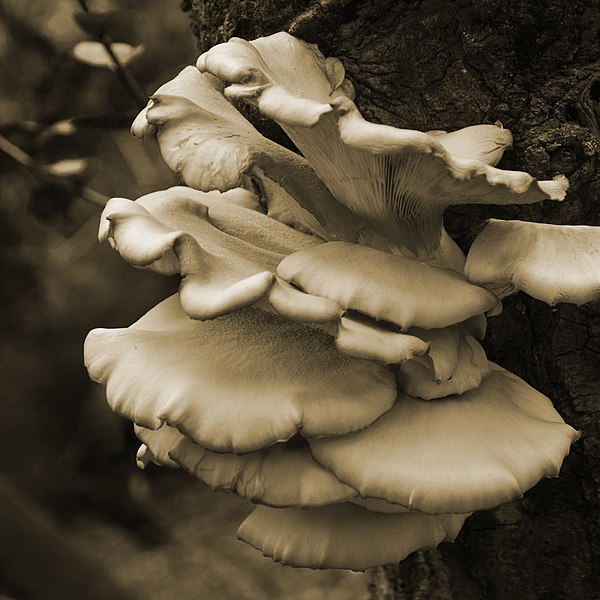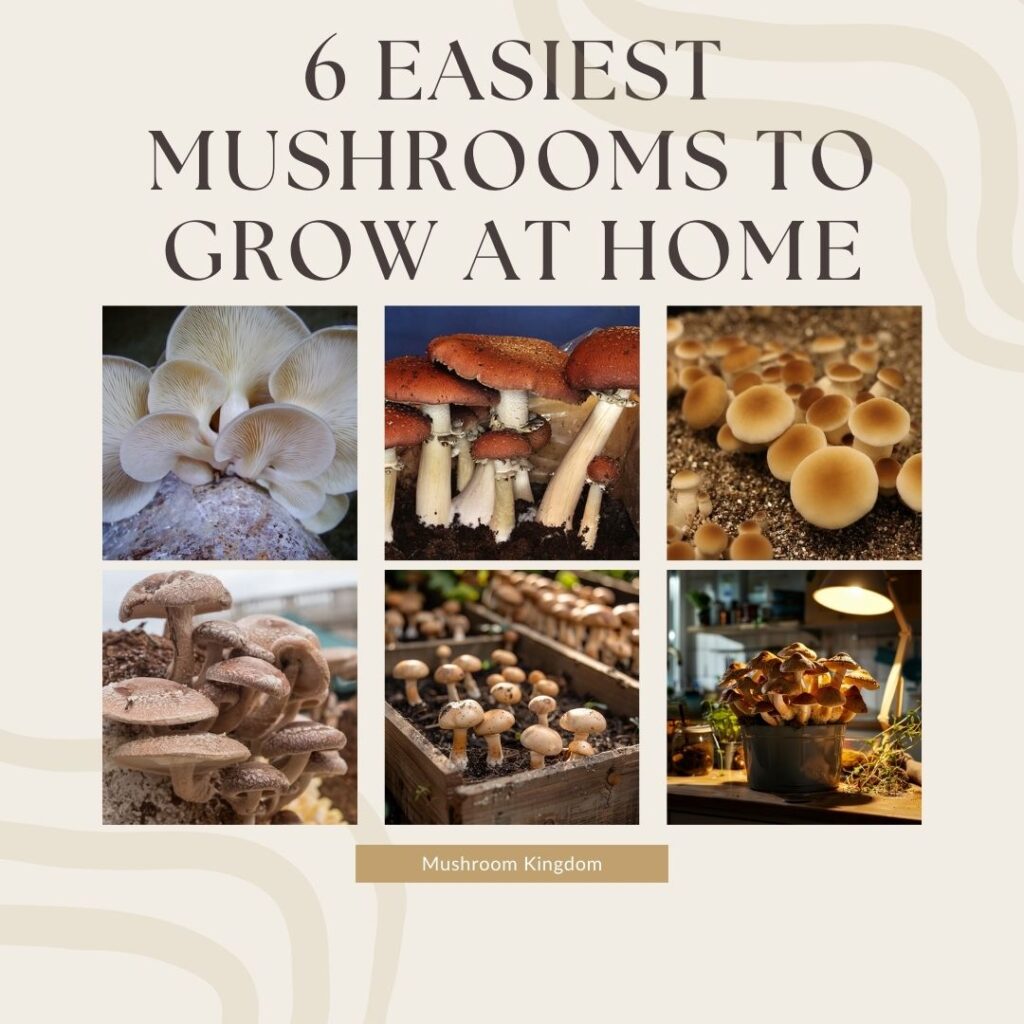Oyster mushrooms (Pleurotus ostreatus) is a popular choice among foragers and culinary enthusiasts alike.
Known for their delicate flavor and versatility in cooking, these fungi are not only edible but also nutritious.
This analysis will explore how to identify oyster mushrooms in the wild, their edibility and potential toxicity, methods to cook them, and the look-alikes to be cautious of when foraging.
Oyster Mushroom Identification
Let’s explore the key characteristics you should look for:
Shape and Size
Oyster mushrooms feature a distinctive fan or oyster-shaped cap. The cap’s diameter can range from 2 to 10 inches. Its surface is typically smooth and can vary in color, presenting shades of white, gray, or tan.

This unique shape and size make them relatively easy to spot once you know what to look for.
Gills
The gills are another defining characteristic. They are white to light gray and run down the stem, a feature known as decurrent gills.
These gills are closely spaced and often forked near the edge of the cap. This gill structure is a reliable indicator that you have found an oyster mushroom.
Stem
The stem of an oyster mushroom is short and stubby, or sometimes even absent. When present, it is usually off-center, connecting the mushroom to its substrate. This off-center attachment is a helpful clue when differentiating oyster mushrooms from other species.
Spore Print
To further confirm your identification, you can check the spore print.
Pleurotus ostreatus produces a white to lilac-gray spore print. To obtain a spore print, place the cap gill-side down on a piece of paper and leave it for a few hours.
The resulting spore print color can be a definitive method of identification, particularly when in doubt.
Habitat They Grow In
Pleurotus ostreatus typically grow on dead or dying hardwood trees, such as beech, oak, and aspen. They favor decaying wood and can often be found in clusters that overlap like shingles. This clustering habit is another useful identifying feature.
Season
While oyster mushrooms can be found year-round in temperate climates, they are most prolific during the spring and fall. These seasons provide the ideal conditions for their growth, so foragers should be particularly vigilant during these times.
Are Oyster Mushrooms Edible?
Yes, oyster mushrooms are not only edible but also a prized ingredient in various cuisines.
They have a mild, anise-like aroma and a delicate texture, making them a versatile addition to many dishes. These mushrooms are also very nutritious. They are a great source of protein, fiber, vitamins (especially B vitamins), and minerals such as zinc and potassium.
Eating this specific mushroom can also help you lose weight. They are low in calories and fat, making them suitable for weight management. Also, oysters contain compounds like beta-glucans, which have been linked to immune-boosting and cholesterol-lowering effects.
Pleurotus ostreatus Look-Alikes to Be Aware Of
While oyster mushrooms are relatively easy to identify, several look-alikes can cause confusion. Some of these look-alikes are edible, while others are toxic. Here are a few to be aware of:
- Angel Wings (Pleurocybella porrigens): These mushrooms are similar in appearance but are smaller and more delicate. They grow on conifer wood rather than hardwood. While generally considered edible, there have been reports of toxicity in some individuals, particularly in Japan.
- Elm Oyster (Hypsizygus ulmarius): Despite the name, elm oysters are not true oyster mushrooms. They have a more robust stem and a firmer texture. Elm oysters are edible and often mistaken for oyster mushrooms.
- Pale Oyster (Pleurotus pulmonarius): This species closely resembles the true Pleurotus ostreatus but tends to be lighter in color and grows more frequently during the summer months. Pale oysters are edible and have a similar flavor profile.
- Ghost Fungus (Omphalotus nidiformis): This toxic look-alike glows in the dark due to bioluminescence. Ghost fungi have a similar cap shape and color to Pleurotus ostreatus but grow on eucalyptus trees. Consuming ghost fungi can lead to severe gastrointestinal distress.
- Jack-O’-Lantern (Omphalotus illudens): Another toxic look-alike, the Jack-O’-Lantern mushroom, has bright orange gills and emits a faint glow in the dark. Unlike Pleurotus ostreatus, their gills do not run down the stem.
Health Benefits of Eating Oyster Mushrooms
Oyster mushrooms offer numerous health benefits, making them a valuable addition to any diet. Here are some of the key benefits:
Rich in Nutrients
They are packed with essential nutrients, including vitamins (B1, B2, B5, B6, and B12), minerals (iron, zinc, potassium, phosphorus), and dietary fiber. These nutrients are vital for maintaining overall health and well-being.
Immune System Support
These mushrooms contain beta-glucans, a type of polysaccharide that has been shown to boost the immune system. Beta-glucans enhance the activity of macrophages and natural killer cells, helping the body fend off infections and diseases.
Antioxidant Properties
Naturally, oyster mushrooms are rich in antioxidants, such as ergothioneine and selenium. Antioxidants help neutralize free radicals, reducing oxidative stress and the risk of chronic diseases like cancer and heart disease.
Cholesterol Reduction
Studies have shown that oyster mushrooms can help lower cholesterol levels. The presence of statin-like compounds, particularly lovastatin, helps reduce LDL (bad) cholesterol and improve overall heart health.
Anti-Inflammatory Effects
The anti-inflammatory properties can help alleviate symptoms of inflammatory conditions, such as arthritis and asthma. These effects are largely due to the presence of compounds like ergosterol and triterpenoids.
Blood Sugar Regulation
Oyster mushrooms have a low glycemic index and can help regulate blood sugar levels. They contain bioactive compounds that improve insulin sensitivity and glucose metabolism, making them beneficial for individuals with diabetes or at risk of developing diabetes.
Cancer-Fighting Potential
Research suggests that Pleurotus ostreatus may have anti-cancer properties. Certain compounds in these mushrooms, such as polysaccharides and proteoglycans, have been shown to inhibit the growth of cancer cells and boost the immune response against tumors.
Digestive Health
The high fiber content in oyster mushrooms promotes healthy digestion. Fiber aids in bowel regularity prevents constipation and supports a healthy gut microbiome.
Low In Calories
Oyster mushrooms are low in calories and fat, making them an excellent food choice for weight management. Their high protein and fiber content also contribute to a feeling of fullness, reducing overall calorie intake.
How to Prepare Oyster Mushrooms
Cooking oyster mushrooms is straightforward, and their delicate flavor pairs well with a variety of dishes. Here are some popular methods:
- Sautéing: Heat some olive oil or butter in a pan over medium heat. Add cleaned and sliced oyster mushrooms. Cook for 5–7 minutes until they are tender and slightly browned. Season with salt, pepper, and herbs of choice. Sautéed oyster mushrooms make a great side dish or topping for salads and pizzas.
- Stir-Frying: Oyster mushrooms are excellent in stir-fries. Combine them with vegetables, garlic, ginger, and your favorite protein. Stir-fry over high heat for a quick and healthy meal.
- Soups and Stews: Add mushrooms to soups and stews for extra flavor and texture. They work particularly well in miso soup, chicken soup, and hearty vegetable stews.
- Grilling: Marinate whole or halved oyster mushrooms in olive oil, lemon juice, garlic, and herbs. Grill them over medium heat until they are tender and slightly charred.
- Roasting: Toss the mushrooms with olive oil, salt, and pepper. Spread them on a baking sheet and roast in a preheated oven at 400°F (200°C) for 20–25 minutes, stirring halfway through.


